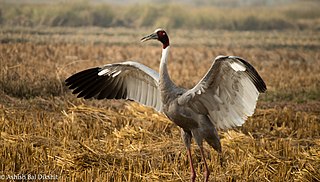 W
WThe Dhanauri Wetlands is a birdwatching area located in Thasrana, Uttar Pradesh, India.
 W
WAna Sagar Lake is an artificial lake situated in the city of Ajmer in Rajasthan state in India. It was built by Arnoraja, the grandfather of Prithviraj Chauhan, in 1135 -1150 AD and is named after him. The catchments were built with the help of local populace. The lake is spread over 13 km (8.1 mi). The Baradari or pavilions were built by Shahjahan in 1637 and Daulat Bagh Gardens by Jehangir.
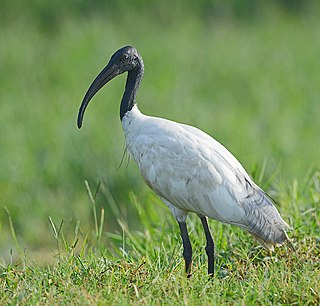 W
WBasai wetland, located in Basai village in Gurgaon tehsil in Gurgaon district in Haryana, India, is a flora and fauna rich water body. It is recognised as one of India's Important Bird and Biodiversity Areas and is of global conservation significance as it supports populations of several endangered, vulnerable, and threatened bird species. Basai wetlandis recognised globally as an Important Bird Area (IBA) by the BirdLife International housing 20,000 birds of over 280 species including migratory birds and endangered birds, has not yet been declared a protected wetland by the Government of Haryana.
 W
WBhalswa Horseshoe Lake, or Bhalswa Jheel, is a lake in northwest Delhi, India. It was originally shaped like a horseshoe. However, over the years half of it was used as a landfill area. Now a low income housing colony, an extension of the nearby town of Bhalswa Jahangir Puri has been built on it, destroying the once excellent wetland ecosystem and wildlife habitat of the region which once played host to scores of local and migratory wildlife species, especially waterbirds, including waterfowl, storks and cranes. This horseshoe lake was originally formed when the nearby River Yamuna left behind one of its meandering loops here when it changed course over the years and is now channelled through more defined and fortified embankments and dykes to defend modern Delhi from floods.
 W
WBhindawas Wildlife Sanctuary is located in Jhajjar district, which is about 15 km from Jhajjar town. On 3rd June 2009, it is also declared as bird sanctuary by Indian Government.
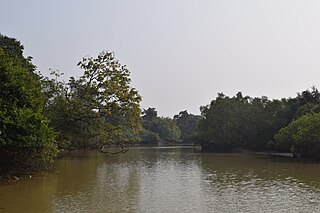 W
WBhitarkanika Mangroves is a mangrove wetland in Odisha, India, covering an area of 650 km (400 mi) in the Brahmani and Baitarani river deltas.
 W
WBlue Bird Lake, Hisar is a resident and endangered migratory bird wetland habitat, lake and recreation area in the town of Hisar, in the Hisar district of Haryana State, India.
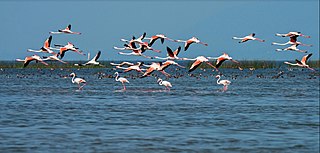 W
WChilika Lake is a brackish water lagoon, spread over the Puri, Khurda and Ganjam districts of Odisha state on the east coast of India, at the mouth of the Daya River, flowing into the Bay of Bengal, covering an area of over 1,100 km. It is the largest coastal lagoon in India and the second largest brackish water lagoon in the world after The New Caledonian barrier reef. It has been listed as a tentative UNESCO World Heritage site.
 W
WThe Gokul barrage, also Mathura barrage is a barrage on Yamuna River at Gokul in Mathura district, top of which also serves as the road bridge.
 W
WHarike Wetland also known as "Hari-ke-Pattan", with the Harike Lake in the deeper part of it, is the largest wetland in northern India in the border of Tarn Taran Sahib district and Ferozepur district of the Punjab state in India.
 W
WThe Hokersar is a wetland conservation area in Zainakote near Srinagar in the Indian-administered Jammu and Kashmir region. It lies in the Kashmir Valley, 10 kilometres (6.2 mi) northwest of Srinagar. The Hokersar, which spreads over 1,375 hectares (13.75 km2), is a designated bird sanctuary.
 W
WThe ITO barrage, also Indraprastha barrage and ITO Bridge, is a 552 meter barrage on Yamuna River, top of which also serves as the bridge on the Paharganj-Gaziabad Vikas marg. Yamuna flows for 48 km in Delhi, including 22 km from Wazirabad barrage where it enters Delhi to Okhla barrage after which it enters Haryana. Upstream barrage from ITO barrage in Delhi is Wazirabad barrage (north) and downstream is Okhla barrage (south). Yamuna has a total of 6 barrages, from north-west to south-east, Dakpathar Barrage (Uttarakhand), Hathni Kund Barrage, Wazirabad barrage, ITO barrage, Okhla barrage and Mathura barrage.
 W
WKaliveli Lake, or Kaliveli Lagoon, is a coastal lake and lagoon with wetlands in the Viluppuram District of Tamil Nadu state, in eastern South India.
 W
WKanjia Lake is a natural lake on the northern outskirts of Bhubaneswar, Odisha, India. While the main lake covers 75 hectares, the total wetland covers an area of 105 hectares with the scuba diving facility. It has a rich biodiversity and is a wetland of national importance which is helpful for maintaining the city's ecology.
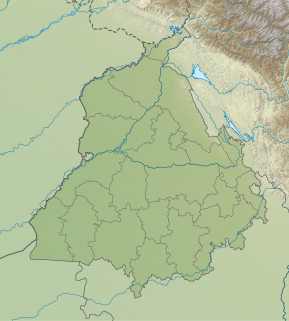 W
WKanjli Wetland, a man made Wetland, which subsumes the Kanjli Lake, located in the Kapurthala district of Punjab state in India, was created in 1870 by constructing the headworks across the perennial Bien River, a tributary of the Beas River to provide irrigation facilities to the hinterland. The rich biodiversity of the wetland comprising aquatic, mesophytic and terrestrial flora and fauna including some important species of plants and animals was recognized internationally by the Ramsar Convention in 2002 by designating the Kanjli Lake in the List of Wetlands of International Importance. In this context, it is reported that the Punjab State which has 14 wetlands covering an area of 225.76 km2 has the unique position of three of its wetlands viz., the Kanjli Wetland covering an area of 490 ha of which the Kanjli Lake water spread is 184 ha), the Harike Wetland and the Ropar Wetland chosen by the Ministry of Environment and Forest (MoE&F), Government of India for their conservation and management are now also included in the Ramsar list covering a total area of 5650 ha; Kanjli is upstream of Harike wetland located in the Beas river basin while the Ropar wetland is in the Roopnagar district.
 W
WThe Kaushalya Dam is an earth-fill embankment dam on the Kaushalya river, which is a tributary of Ghaggar-Hakra River, in Pinjore of Haryana state, India. It was constructed between 2008 and 2012 with the primary purpose of water supply.
 W
WKayamkulam Kayal, Kayamkulam Lake or Kayamkulam Estuary is a shallow brackish water lagoon streaching between Panmana and Karthikapally. It has an outlet to the Arabian sea at Kayamkulam barrage. The Kayal used to be connected to the sea most of the time except during dry season when a bar like formation separates it from the sea. Now the bar has been opened up permanently for construction of Kayamkulam Fishing Harbor. Kayamkulam boat race is conducted in Kayamkulam Kayal.
 W
WKhaparwas Bird Sanctuary is a bird sanctuary in Jhajjar district, about 80 kilometres (50 mi) west of Delhi). The reserve covers 82.70 hectares. This is an important part of ecological corridor along the route of Sahibi River which traverses from Aravalli hills in Rajasthan to Yamuna via Masani barrage, Matanhail forest, Chhuchhakwas-Godhari, Khaparwas Wildlife Sanctuary, Bhindawas Wildlife Sanctuary, Outfall Drain Number 8 and 6, Sarbashirpur, Sultanpur National Park, Basai and The Lost Lake (Gurugram). It lies 5km northwest of Bhindawas Bird Sancturay and 46 km northwest of Sultantpur National Park via road.
 W
WKongur is a freshwater wetland located in Tirupur District, Tamil Nadu, India.
 W
WKothaimangalam Wetlands are located near to Palani, Tamil Nadu, India. The huge lakes are the habitat for lot of Migratory birds. One of the wetland is adjacent to the Shanmuganadhi river.
 W
WMasani barrage, also Masani bridge, a barrage on the seasonal Sahibi River completed in 1989, is named after the Masani village in Rewari District of Haryana in India. Masani barrage also serves as a bridge on NH 919. Water storage in the barrage was made perennial in 2017 after a gap of 50 years. This barrage is important part of ecological corridor along the route of Sahibi river which traverses from Aravalli hills in Rajasthan to Yamuna via Matanhail forest, Chhuchhakwas-Godhari, Khaparwas Wildlife Sanctuary, Bhindawas Wildlife Sanctuary, Outfall Drain Number 8 and 6, Sarbashirpur, Sultanpur National Park, Basai and The Lost Lake (Gurugram).
 W
WNajafgarh drain bird sanctuary (proposed) and wetland ecosystem is composed of the wetland ecosystem and wildlife habitat on several kilometres of the Najafgarh drain or nullah which passes through rural southwest Delhi in India's capital territory. It includes the portion draining the depression or basin area that formed the once famous but now completely drained Najafgarh lake or Najafgarh jheel.
 W
WThe Okhla barrage, is 791 meters or roughly 800-yard long weir across Yamuna River opened in 1874, is today the location of Okhla Bird Sanctuary 10 km to the south of New Delhi and downstream of Nizamuddin bridge at Okhla, where Agra canal originates from it. The top of barrage also serves as the Delhi-Noida carriageway of Mahamaya-Kalindi Kunj road. Nearby later-era New Okhla Barrage is 554 meters long.
 W
WOkhla Bird Sanctuary officially known as Shaheed Chander Shekhar Azad Sanctuary is a bird sanctuary at the Okhla barrage over Yamuna River. It is situated in Noida, Gautam Buddh Nagar district, on Delhi-Uttar Pradesh state border and known as a haven for over 300 bird species, especially waterbirds. In 1990, an area of 3.5 square kilometres (1.4 sq mi) on the river Yamuna was designated a bird sanctuary by the Government of Uttar Pradesh under the Wildlife Protection Act, 1972. The site is located at the point where the river enters Uttar Pradesh. The most prominent feature of the sanctuary is the large lake created by damming the river, which lies between Okhla village to the west and Gautam Budh Nagar to the east. The Okhla Bird Sanctuary (OBS) is roughly 4 square kilometres in size and is situated at the entrance of NOIDA in Gautam Budh Nagar district of Uttar Pradesh. It is situated at a point where river Yamuna enters in the state of Uttar Pradesh leaving the territory of Delhi. It is one among fifteen bird sanctuaries in the state.
 W
WPallikaranai wetland is a freshwater marsh in the city of Chennai, India. It is situated adjacent to the Bay of Bengal, about 20 kilometres (12 mi) south of the city centre, and has a geographical area of 80 square kilometres (31 sq mi). Pallikaranai marshland is the only surviving wetland ecosystem of the city and is among the few and last remaining natural wetlands of South India. It is one of the 94 identified wetlands under National Wetland Conservation and Management Programme (NWCMP) operationalised by the Government of India in 1985–86 and one of the three in the state of Tamil Nadu, the other two being Point Calimere and Kazhuveli. It is also one of the prioritised wetlands of Tamil Nadu. The topography of the swamp is such that it always retains some storage, thus forming an aquatic ecosystem. A project on 'Inland Wetlands of India' commissioned by the Ministry of Environment and Forests, Government of India had prioritised Pallikaranai marsh as one of the most significant wetlands of the country. The marsh contains several rare or endangered and threatened species and acts as a forage and breeding ground for thousands of migratory birds from various places within and outside the country. The number of bird species sighted in the wetland is significantly higher than the number at Vedanthangal Bird Sanctuary.
 W
WThe Panje-Dongri wetlands is located in the coastal town of Uran, Navi Mumbai in Raigad district of Maharashtra in India. It is a major bird watching site in Mumbai Metropolitan Region (MMR). The wetland is home to 1.4 lakhs migratory birds in the winter. It is the last surviving wetland at Uran.
 W
WPulicat Lagoon is the second largest brackish water lagoon in India, after Chilika Lake. Pulicat Lagoon is considered to be the second largest brackish water body in India measuring 759 square kilometres (293 sq mi). The lagoon is one of the three important wetlands to attract northeast monsoon rain clouds during the October to December season in the Tirupati Region. The lagoon comprises the following regions, which adds up 759 square kilometres (293 sq mi) according to Andhra Pradesh Forest Department: 1) Pulicat Lake 2) Marshy/Wetland Land Region (AP) 3) Venadu Reserve Forest (AP) 4) Pernadu Reserve Forest (AP) The lagoon was cut across in the middle by the Sriharikota Link Road, which divided the water body into lagoon and marshy land. The lagoon encompasses the Pulicat Lake Bird Sanctuary. The barrier island of Sriharikota separates the lagoon from the Bay of Bengal and is home to the Satish Dhawan Space Centre. Major part of the lagoon comes under Nellore district of Andhra Pradesh.
 W
WRopar Wetland, also named Ropar Lake, is a man-made freshwater riverine and lacustrine wetland. The area has at least 9 mammal, 154 bird, 35 fish, 9 arthropod, 11 rotifer, 9 crustacean and 10 protozoan species, making it biologically diverse. This important ecological zone is located in the Shivalik foothills of the Lower Himalayas and was created in 1952 on the Sutlej River, in the Punjab state of India, by building a head regulator to store and divert water for beneficial uses of irrigation, drinking and industrial water supply. The endangered turtle Chitra indica and the threatened snake Python molurus, as per IUCN Red List, are reported to be resident in the wetland. Considering the wetland's diverse and rich biodiversity, Ramsar Convention has included Ropar Wetland as one of the Ramsar sites among the 27 sites listed under India, for "the conservation of global biological diversity and for sustaining human life through the ecological and hydrological functions they perform."
 W
W}}
 W
WSaraswati Wildlife Sanctuary, also known as Seonsar Forest, is situated in Kaithal district of Haryana State, India. It is spread over an area of 4,452.85 hectares.
 W
WSarsai Nawar Wetland, also known as Sarsai Nawar Jheel is a bird sanctuary in Sarsai Nawar, Etawah district, Uttar Pradesh, India. It aims to conserve waterbirds, notably the Sarus Crane. It has been designated as a protected Ramsar site since 2019.
 W
WThe Sundarbans is a mangrove area in the delta formed by the confluence of the Ganges, Brahmaputra and Meghna Rivers in the Bay of Bengal. It spans from the Hooghly River in India's state of West Bengal to the Baleswar River in Bangladesh. It comprises closed and open mangrove forests, agriculturally used land, mudflats and barren land, and is intersected by multiple tidal streams and channels. Four protected areas in the Sundarbans are enlisted as UNESCO World Heritage Sites, viz. Sundarbans National Park, Sundarbans West, Sundarbans South and Sundarbans East Wildlife Sanctuaries. Despite these protections, the Indian Sundarbans were considered endangered in a 2020 assessment under the IUCN Red List of Ecosystems framework.
 W
WThe Terai or Tarai is a lowland region in northern India and southern Nepal that lies south of the outer foothills of the Himalayas, the Sivalik Hills, and north of the Indo-Gangetic Plain. This lowland belt is characterised by tall grasslands, scrub savannah, sal forests and clay rich swamps. In northern India, the Terai spreads from the Yamuna River eastward across Haryana, Uttarakhand, Uttar Pradesh, Bihar and West Bengal. The Terai is part of the Terai-Duar savanna and grasslands ecoregion. The corresponding lowland region in West Bengal, Bangladesh, Bhutan and Assam in the Brahmaputra River basin is called 'Dooars'. In Nepal, the Terai stretches over 33,998.8 km2 (13,127.0 sq mi), about 23.1% of Nepal's land area, and lies at an altitude of between 67 and 300 m. The region comprises more than 50 wetlands. North of the Terai rises the Bhabar, a narrow but continuous belt of forest about 8–12 km (5.0–7.5 mi) wide.
 W
WThrissur Kole Wetlands is a wetland lying in Thrissur District in Kerala, India. It gives 40 per cent of the Kerala’s rice requirement and acts as a natural drainage system for Thrissur city and Thrissur District. The Kole Wetlands is one of largest, highly productive and threatened wetlands in Kerala and it comes in Central Asian Flyway of migratory birds. [[File:Journey of bhagavathi.jpg|thumb|right|Kole Wetlands in [[Puzhakkal,Enamavu], Thrissur City]]
 W
WThe Wazirabad barrage or Wazirabad bridge, built in 1959 is a 1,491 ft long weir across Yamuna River, in north Delhi. Downstream barrages in Delhi are ITO barrage and then Okhla barrage. It is under the management of Delhi govt, where as ITO barrage is managed by Haryana and Okhla barrage is managed by UP govt.